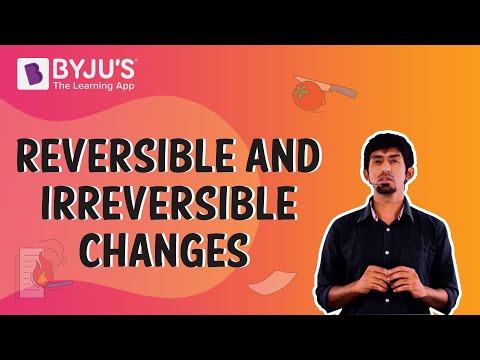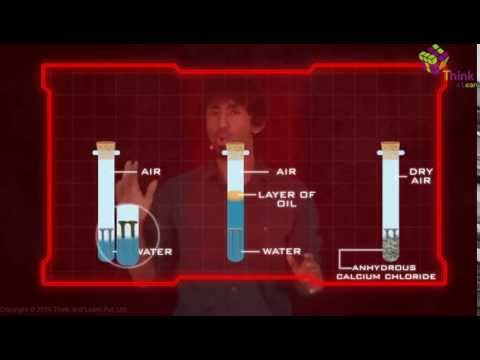Class 6 chemistry important questions with answers are provided here for Chapter 6 – Changes Around Us. These important questions are based on the CBSE board curriculum and correspond to the most recent Class 6 chemistry syllabus. By practising these Class 6 important questions, students will be able to quickly review all of the ideas covered in the chapter and prepare for the Class 6 annual examinations.
Download Class 6 Chemistry Chapter 6 – Changes Around Us Important Questions with Answers PDF by clicking on the button below.
Recommended Videos
Can All Changes Be Reversed?

What is Physical and Chemical Change?

Changes Around Us – MENTI Quiz

Different Ways to Bring a Change

Class 6 Chapter 6 – Changes Around Us Important Questions with Answers
Fill in the Blanks
i.) Dissolving salt in water is a ____ change.
ii.) If we inflate a balloon, the balloon’s shape and size will change. This is a ____ change.
iii.) The burning of wood is a ____ change.
iv.) Materials ____ on heating and ____ on cooling.
v.) Conversion of water into ____ is a reversible change.
Answer.
i.) Dissolving salt in water is a reversible change.
ii.) If we inflate a balloon, the balloon’s shape and size will change. This is a reversible change.
iii.) The burning of wood is a chemical change.
iv.) Materials expand on heating and contract on cooling.
v.) Conversion of water into water vapour is a reversible change.
State True or False
i.) All changes are reversible.
ii.) The heating of wax to molten wax is a reversible change.
iii.) Drying wet clothes is a reversible change.
iv.) The formation of paneer is a reversible change.
v.) Metals contract on heating.
Answer.
i.) False
ii.) True
iii.) True
iv.) False
v.) False
Match the Following
| a.) Boiling egg | i.) Expansion |
| b.) Heating | ii.) Fast change |
| c.) Ripening of fruit | iii.) Contraction |
| d.) Cooling | iv.) Irreversible change |
| e.) Blowing of balloon | v.) Slow change |
Answer.
| a.) Boiling egg | iv.) Irreversible change |
| b.) Heating | i.) Expansion |
| c.) Ripening of fruit | v.) Slow change |
| d.) Cooling | iii.) Contraction |
| e.) Blowing of balloon | ii.) Fast change |
Very Short Answer Questions
Q1. A box is wrapped in a rope and the shape of the rope changes. What kind of change is this?
Answer. This is a change that can be reversed. Hence, it is a reversible change.
Q2. Can wood be obtained from sawdust?
Answer. No, it is an irreversible change.
Q3. Define reversible change.
Answer. Changes that can be reversed are referred to as reversible changes. For example, the glowing of an electric bulb. It glows when turned on and goes dark when turned off.
Q4. Define irreversible change.
Answer. Changes that cannot be reversed are referred to as irreversible changes. For example, paper or wood burning. It emits smoke and ash, which cannot be converted back into paper or wood.
Q5. Give two examples of slow changes.
Answer. Formation of day and night and rusting of iron.
Q6. What type of change is stretching of a rubber band?
Answer. Reversible change.
Q7. What changes occur in a lightning matchstick? What is the nature of the change?
Answer. A match stick turns into ash, and this transformation is irreversible.
Q8. What type of change is folding a copper wire to form a loop?
Answer. Reversible change.
Q9. What is combustion?
Answer. Combustion is the process by which a substance burns in the presence of oxygen, emitting heat and light.
Q10. The flavour of vegetables changes when they are cooked. Can we reverse this change?
Answer. No.
Short Answer Questions
Q1. The melting of ice is a reversible change. Why?
Answer. The melting of ice is a reversible change because ice melts into water, but the water can be frozen again to become ice.
Q2. What type of change is ironing clothes?
Answer. Ironing removes wrinkles from clothes, and the clothes can get wrinkled again, which can then be ironed again. As a result, ironing clothes is a reversible change.
Q3. Define expansion.
Answer. When a substance is heated, it increases in size. Thus, expansion is the process by which an object expands when heated.
Q4. What kind of change is deforestation?
Answer. Deforestation is not a change that can be reversed. It is a permanent change. It cannot occur in the opposite direction because when we cut down a tree, the plant’s life and the habitat of some animals are permanently lost and cannot be replaced.
Q5. Why is folding paper to form aeroplanes a reversible change?
Answer. The paper aeroplane can be unfolded to return the paper to its original form. The change made to the paper by folding is reversible. As a result, the change is reversible.
Q6. What types of changes can be observed?
Answer. The following types of changes have been observed:
- Change in shape
- Change in size
- Change in colour
- Change in state
- Change in direction
Q7. Define chemical change.
Answer. A chemical change is the change of a substance into a new substance with a different chemical composition.
For example, burning wood/trees/paper, rusting iron, setting curd, etc.
Q8. What is a slow change?
Answer. Changes that occur over a long period of time are referred to as slow changes. Examples – Slow changes include the rusting of iron, the formation of day and night, the ripening of fruits, and the growth of trees.
Q9. What is a fast change?
Answer. Changes that occur over a short period of time are referred to as fast changes.
Examples – Paper burning, rubber band stretching, balloon blowing, and cracker bursting are examples of quick changes.
Q10. What is a physical change?
Answer. A physical change occurs when a substance undergoes a change in its physical properties. Physical changes are usually reversible. There is no new substance formed as a result of such a change.
Long Answer Questions
Q1. How is an iron blade attached to a wooden handle in soil-digging tools?
Answer. The wooden handle is attached to the iron tool’s blade via a ring. The ring is typically slightly smaller in size than the wooden handle. To secure the handle, the ring is heated and expanded. The handle now fits snugly into the ring. When the ring cools, it contracts and fits into the handle.
Q2. When is a material said to have changed? Give an example.
Answer. We have a lot of things around us. These things have properties like state (liquid, solid, gas), position, shape, size, colour, temperature, composition, and structure, among other things. When one or more properties of a thing change, we say that it has changed or that a change has occurred; changes involve various types of alterations in the things around us.
When there is a change, the state, position, colour, temperature, composition, or structure of the object’s material may change. Water is formed when the ice melts. Water is a liquid, whereas ice is a solid. As a result, ice melting involves a change.
Q3. Differentiate between reversible and irreversible change.
Answer.
| A change is called irreversible if it cannot be changed back again. | A reversible change is a change that can be reversed. |
| For example, you cannot change a cake back into its ingredients again. | For example, melted chocolate can be changed back into solid chocolate by cooling. |
| Irreversible changes are permanent. They cannot be undone. | Reversible changes are not permanent. They can be undone. |
| In an irreversible reaction, the reactants react to form the products, which cannot revert back into reactants. | In reversible reactions, as the reactants react with other reactants to form products, the products are reacting with other products to form reactants. |
Q4. Give some examples of changes that occur on their own.
Answer. Many changes are occurring around us on their own, for example:
- The ripening of crops in the fields.
- Trees lose their leaves.
- Flowers bloom, then fade away.
- Growing of hair and nails.
Q5. How is a metal rim attached to a wooden cartwheel? What changes are made in that metal?
Answer. The metal rim is designed to be slightly smaller than the wooden wheel. When heated, the rim expands and fits into the wheel. After that, cold water is poured over the rim, which contracts the wheel and fits snugly onto the wheel.
Read Also:
- Reversible and Irreversible Changes
- Chemical Change
- Chemical and Physical Change
- Difference between Physical and Chemical Change
- Chemistry Worksheet Class 6 on Chapter 6 Changes Around Us with Answers – Set 1
- Chemistry Worksheet Class 6 on Chapter 6 Changes Around Us with Answers – Set 2
- Chemistry Worksheet Class 6 on Chapter 6 Changes Around Us with Answers – Set 3
- Class 6 Chemistry Chapter 6 Changes Around Us MCQs
- Chemistry Concept Questions and Answers
Related Videos
Reversible and Irreversible Changes

Corrosion of Metals
